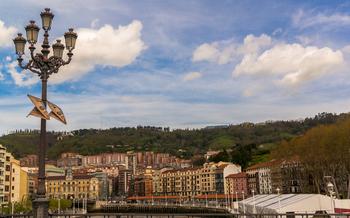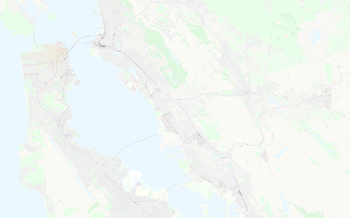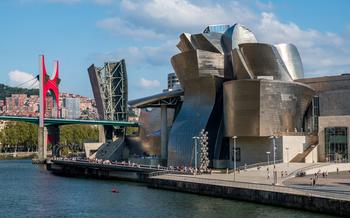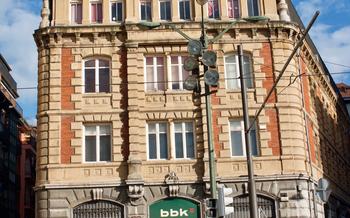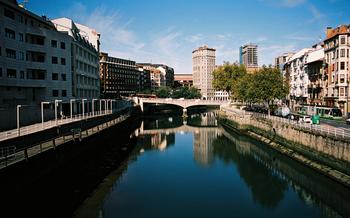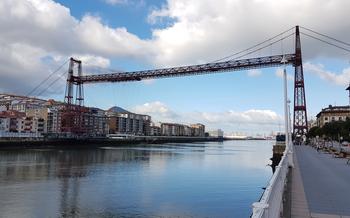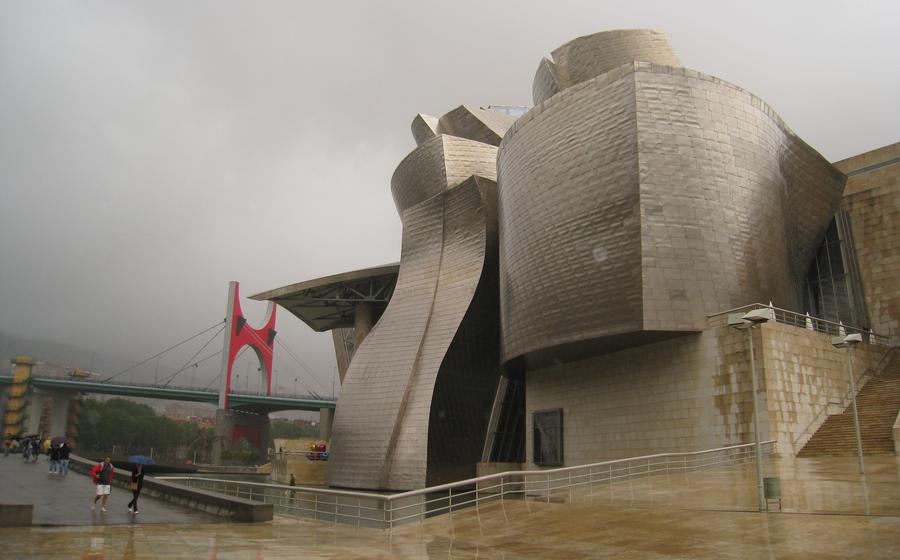
Kurtzio Cultural Center
- A City Upended
- Bilbao's Art and Culture
- Visiting the Kurtzio Cultural Center
- The Guggenheim Museum Bilbao
- History
- Architecture
- Exhibits
- Role in the Bilbao Community
- The Bilbao Fine Arts Museum
- The Maritime Museum
- Bilbao's Theaters and Concert Halls
- Bilbao's Art Galleries
- Bilbao's Festivals and Events
- Bilbao's Nightlife
- Getting Around Bilbao
- Bilbao's Transportation Network
- Taxis and Bike Sharing
- Walking Tours
- Insider Tip: Explore Bilbao's Hidden Corners on Foot
- Where to Stay in Bilbao
- Where to Eat in Bilbao
A City Upended
Once upon a time, in the Basque Country of Spain, nestled along the Nervion River, Bilbao slumbered as an industrial hub. Its days were filled with the hum of factories and the clatter of shipyards. However, a profound transformation awaited this unassuming city. In 1997, the Guggenheim Museum Bilbao burst onto the scene, designed by the visionary architect Frank Gehry. This architectural masterpiece, with its gleaming titanium curves, became a symbol of Bilbao's audacious rebirth. The city shed its industrial skin, embracing a vibrant cultural identity that continues to captivate visitors from around the world.
Bilbao's metamorphosis is a testament to the power of art to revitalize and redefine a city. The Guggenheim Museum Bilbao, with its world-renowned exhibitions, became a magnet for art enthusiasts, injecting new life into Bilbao's cultural landscape. The city's once-overlooked streets and plazas transformed into a canvas for artistic expression, with sculptures, murals, and installations adorning every corner. Today, Bilbao stands as a vibrant, cosmopolitan city, where art and culture thrive, and the spirit of innovation pulses through its veins.
Bilbao's Art and Culture
Bilbao is a city that has embraced its industrial past and transformed itself into a vibrant, cosmopolitan city with a thriving arts and culture scene. The city is home to a number of world-class museums, including the Guggenheim Museum Bilbao, the Bilbao Fine Arts Museum, and the Maritime Museum. There are also many theaters, concert halls, and art galleries in the city, as well as a number of festivals and events that take place throughout the year.
The Guggenheim Museum Bilbao is perhaps the city's most famous cultural attraction. The museum is home to a collection of modern and contemporary art, including works by Picasso, Warhol, and Rothko. The museum's building, designed by Frank Gehry, is a work of art in itself, and has become a symbol of the city's transformation.
The Bilbao Fine Arts Museum is another important cultural institution in the city. The museum houses a collection of paintings, sculptures, and drawings from the 13th to the 21st centuries. The museum's collection includes works by El Greco, Goya, and Velázquez.
The Maritime Museum is a must-visit for anyone interested in the history of Bilbao and its relationship with the sea. The museum tells the story of Bilbao's maritime past, from its early days as a fishing village to its role as a major shipbuilding center. The museum also has a number of exhibits on the Basque Country's maritime culture.
Bilbao's theaters and concert halls offer a variety of performances, from classical music to contemporary dance. The city's many art galleries showcase the work of local and international artists. Bilbao's festivals and events celebrate the city's culture and history, and offer a variety of activities for visitors to enjoy.
The city's vibrant nightlife scene is another major draw for visitors. Bilbao has a wide variety of bars, clubs, and restaurants to choose from, and the city's streets are always buzzing with activity.
Visiting the Kurtzio Cultural Center
Visiting the Kurtzio Cultural Center is a great way to learn about Basque culture and history. The center is located in the heart of Bilbao, and it is easy to get to by public transportation or on foot. Admission to the center is free, and there are guided tours available in English and Spanish.
The Kurtzio Cultural Center is open from Tuesday to Sunday from 10:00 am to 8:00 pm. The center is closed on Mondays. It is recommended to visit the center during the week, as it is less crowded than on the weekends.
There are many things to see and do at the Kurtzio Cultural Center. The center has a variety of exhibits on Basque culture and history, as well as a theater, a library, and a restaurant. Visitors can also take part in workshops and classes on Basque culture and language.
The Kurtzio Cultural Center is a great place to learn about Basque culture and history. The center is free to visit, and there are many things to see and do. Visitors of all ages will enjoy their time at the Kurtzio Cultural Center.
The Guggenheim Museum Bilbao
History
The Guggenheim Museum Bilbao opened its doors in 1997, and it quickly became one of the most popular tourist attractions in Spain. The museum was designed by Frank Gehry, and it is considered to be one of his most important works. The building is a masterpiece of modern architecture, and it is instantly recognizable with its curved titanium panels.
Architecture
The Guggenheim Museum Bilbao is a striking building that is unlike any other museum in the world. The building is covered in titanium panels that reflect the light in different ways, depending on the time of day. The museum's interior is just as impressive as its exterior. The galleries are spacious and well-lit, and they provide a perfect setting for the museum's collection of modern and contemporary art.
Exhibits
The Guggenheim Museum Bilbao's collection includes works by some of the most famous artists in the world, including Picasso, Van Gogh, and Warhol. The museum also has a number of temporary exhibits that change throughout the year. The museum's collection is constantly evolving, and there is always something new to see.
Role in the Bilbao Community
The Guggenheim Museum Bilbao has played a major role in the revitalization of Bilbao. The museum has brought in millions of tourists to the city, and it has helped to create a new image for Bilbao as a modern and cosmopolitan city. The museum has also had a positive impact on the local economy, and it has helped to create jobs and boost tourism.
The Bilbao Fine Arts Museum
The Bilbao Fine Arts Museum is one of the most important museums in Spain and one of the most visited in Bilbao. It was founded in 1908 and is located in a beautiful building in the heart of the city. The museum has a large collection of paintings, sculptures, and decorative arts from the Middle Ages to the present day.
The museum's collection includes works by some of the most famous artists in the world, including El Greco, Goya, Velázquez, and Picasso. The museum also has a large collection of Basque art, including works by Ignacio Zuloaga, José María Sert, and Jorge Oteiza.
The Bilbao Fine Arts Museum is a great place to learn about the history of Spanish and Basque art. The museum's collection is well-curated and the exhibits are informative and engaging. The museum also offers a variety of educational programs and events for visitors of all ages.
The museum is open Tuesday through Sunday from 10am to 8pm. Admission is €8 for adults, €6 for seniors and students, and free for children under The museum is closed on Mondays.
The Bilbao Fine Arts Museum is a must-see for anyone interested in art or history. The museum's collection is world-class and the exhibits are informative and engaging. The museum is also a great place to learn about the history of Spanish and Basque art.
The Maritime Museum
The Maritime Museum of Bilbao is a must-see for anyone interested in the city's rich maritime history. Founded in 1921, the museum is housed in a beautiful neo-Gothic building on the banks of the Nervión River. The museum's collection includes over 20,000 artifacts, including model ships, maritime charts, and navigational instruments. The museum also has a library and a research center, making it a valuable resource for scholars and enthusiasts alike.
The Maritime Museum is a great place to learn about Bilbao's role in the maritime industry. The museum tells the story of how the city's port grew from a small fishing village into one of the most important ports in Europe. The museum also highlights the role of Basque sailors in the exploration of the Americas and the Pacific Ocean.
The Maritime Museum is a great place to visit for families with children. The museum has many interactive exhibits, including a replica of a 16th-century ship that children can climb aboard. The museum also offers a variety of educational programs for children of all ages.
The Maritime Museum is open Tuesday through Sunday from 10am to 7pm. Admission is €5 for adults, €3 for children, and free for children under
Bilbao's Theaters and Concert Halls
Bilbao has a vibrant theater and concert scene, with a wide range of venues to choose from. The most famous theater is the Arriaga Theatre, which was built in 1890 and is named after the Basque composer Juan Crisóstomo de Arriaga. The theater hosts a variety of performances, including opera, ballet, and plays.
Another popular theater is the Euskalduna Palace, which was built in 1999 and is located on the banks of the Nervión River. The palace hosts a variety of events, including concerts, theater productions, and conferences.
Bilbao is also home to a number of smaller theaters and concert halls, such as the Campos Elíseos Theater, the Bilbao Arena, and the Kafe Antzokia. These venues host a variety of performances, including live music, comedy shows, and film screenings.
The Bilbao Symphony Orchestra is one of the most prestigious orchestras in Spain, and it performs regularly at the Euskalduna Palace. The orchestra is known for its performances of classical music, as well as its collaborations with contemporary composers.
The Bilbao Jazz Festival is one of the most important jazz festivals in Europe, and it takes place every year in July. The festival features a variety of jazz performances, from traditional to contemporary, and it attracts musicians from all over the world.
Bilbao's theaters and concert halls play an important role in the city's cultural life, and they offer a wide range of performances for residents and visitors to enjoy.
Bilbao's Art Galleries
Bilbao is home to a vibrant and thriving art scene, with a number of excellent art galleries showcasing the work of both local and international artists. The galleries are located throughout the city, from the historic Old Town to the modern Art District, and offer a wide variety of exhibitions, from traditional paintings and sculptures to contemporary installations and performance art.
Some of the most popular art galleries in Bilbao include the BilbaoArte Foundation, which features a collection of modern and contemporary art from the Basque Country; the Sala Rekalde, which hosts temporary exhibitions of both local and international artists; and the Galería Vanguardia, which specializes in contemporary art from Spain and Latin America.
For those interested in exploring the local art scene, there are a number of art walks and gallery crawls that take place throughout the city, offering a great way to discover new artists and galleries.
Bilbao's Festivals and Events
Bilbao's festivals and events are a vibrant reflection of the city's rich culture and history. From traditional Basque celebrations to cutting-edge contemporary arts festivals, there's something for everyone in Bilbao's year-round calendar of events.
One of the most popular festivals in Bilbao is Aste Nagusia, or the Big Week, held every August. This week-long street festival is a riot of color, music, and dancing, with parades, concerts, fireworks, and bullfights filling the city's streets.
Another highlight of Bilbao's festival calendar is the Bilbao International Film Festival, held every November. This prestigious festival showcases the latest and greatest in world cinema, with screenings, workshops, and masterclasses attracting film buffs from around the globe.
For music lovers, the Bilbao BBK Live music festival is a must-attend. Held every July, this three-day festival features a diverse lineup of international and local acts, from rock and pop to electronic and hip-hop.
Bilbao's festivals and events play a vital role in the city's cultural landscape, bringing people together to celebrate the city's unique heritage and vibrant arts scene. Whether you're interested in traditional Basque culture, contemporary art, or cutting-edge music, you're sure to find something to your taste in Bilbao's festival calendar.
Tips for attending Bilbao's festivals and events:
- Plan your trip in advance, as many festivals and events sell out quickly.
- Book your accommodation early, as prices tend to rise during peak festival season.
- Wear comfortable shoes, as you'll be doing a lot of walking.
- Bring a camera to capture all the memories.
- Be prepared for crowds, especially during the most popular festivals.
- Respect the local customs and traditions.
- Have fun and enjoy the unique atmosphere of Bilbao's festivals and events!
Bilbao's Nightlife
Bilbao's nightlife scene is vibrant and diverse, offering something for everyone. From traditional Basque taverns to modern nightclubs, there are plenty of places to enjoy a night out in Bilbao.
The Casco Viejo is the best place to experience Bilbao's traditional nightlife. This historic neighborhood is home to many traditional Basque taverns, known as txokos. These taverns are a great place to sample local Basque cuisine and drinks, such as pintxos and txakoli.
For a more modern nightlife experience, head to the Indautxu neighborhood. This trendy neighborhood is home to many bars, clubs, and restaurants, as well as the Bilbao Arena, which hosts concerts and sporting events.
Bilbao is also home to several theaters and concert halls, which offer a variety of live performances, from classical music to rock concerts.
No matter what your taste, you're sure to find something to enjoy in Bilbao's nightlife scene. Here are a few tips for enjoying Bilbao's nightlife:
- Start your night with a few pintxos and a glass of txakoli in the Casco Viejo.
- Head to the Indautxu neighborhood for a more modern nightlife experience.
- Check out the Bilbao Arena for concerts and sporting events.
- See a live performance at one of Bilbao's many theaters or concert halls.
- Don't be afraid to stay out late - Bilbao's nightlife scene doesn't really get going until after midnight.
Getting Around Bilbao
Bilbao's Transportation Network
Bilbao boasts an efficient and comprehensive transportation network that makes getting around the city a breeze. The city's public transportation system, Bilbobus, operates an extensive network of buses that connect all major neighborhoods and attractions. Buses run frequently and are generally reliable, making them a convenient option for both locals and visitors. Additionally, Bilbao has a modern tram system that runs along the banks of the Nervión River, offering a scenic and convenient way to explore the city.
Taxis and Bike Sharing
For those who prefer a more direct route, taxis are readily available throughout Bilbao. Taxi fares are reasonable, and taxis can be hailed on the street or ordered through an app. Bilbao is also a bike-friendly city, with a well-developed network of bike lanes and bike-sharing stations. Visitors can rent bikes from one of the many bike-sharing stations located throughout the city and explore Bilbao on two wheels.
Walking Tours
For those who prefer to explore Bilbao at a slower pace, there are several walking tours available. These tours offer a unique perspective on the city's history, culture, and architecture. Walking tours are typically led by local guides who can provide insider tips and recommendations. Whether you choose to explore Bilbao by bus, tram, taxi, bike, or on foot, you'll find that getting around the city is easy and enjoyable.
Insider Tip: Explore Bilbao's Hidden Corners on Foot
One of the best ways to experience Bilbao's charm is to explore its hidden corners on foot. Wander through the narrow streets of the Casco Viejo, admire the stunning architecture of the Ensanche district, or stroll along the banks of the Nervión River. You'll discover hidden plazas, charming cafes, and unique shops that you might otherwise miss.
Where to Stay in Bilbao
Bilbao offers a wide range of accommodation options to suit all budgets and preferences. From hostels and guesthouses to luxury hotels, there is something for everyone.
The best areas to stay in Bilbao are the Old Town, the Ensanche district, and the Abandoibarra district. The Old Town is the historic heart of Bilbao and is home to many of the city's most popular attractions, including the Guggenheim Museum. The Ensanche district is a more modern area with wide boulevards and elegant architecture. The Abandoibarra district is a newer area that has been developed in recent years and is home to the Euskalduna Conference Centre and Concert Hall.
When choosing a hotel or apartment in Bilbao, it is important to consider your budget, your travel style, and your proximity to the attractions you want to visit. If you are on a tight budget, there are several hostels and guesthouses in Bilbao that offer clean and comfortable accommodation at a reasonable price. If you are looking for a more luxurious experience, there are several five-star hotels in Bilbao that offer stunning views of the city and the surrounding mountains.
No matter what your budget or travel style, you are sure to find the perfect place to stay in Bilbao.
Insider tip: If you are looking for a truly unique experience, consider staying in one of Bilbao's many boutique hotels. These hotels are often housed in historic buildings and offer a more personal and intimate experience than traditional hotels.
Where to Eat in Bilbao
Bilbao is a foodie's paradise, with a wide variety of restaurants to choose from. Whether you're looking for traditional Basque cuisine, modern Spanish fare, or international flavors, you're sure to find something to your taste in Bilbao.
Some of the must-try dishes in Bilbao include pintxos, small snacks that are typically served in bars and restaurants. Popular pintxos include croquetas, tortilla de patatas, and jamón serrano.
For a more substantial meal, try one of Bilbao's many asadores, which specialize in grilled meats. Popular dishes include chuleta de vaca, a grilled steak, and cordero asado, roasted lamb.
If you're looking for something a little different, try one of Bilbao's many sidrerías, which serve cider and traditional Basque dishes. Popular dishes include bacalao al pil pil, codfish in a garlic and chili pepper sauce, and txuleta, a grilled steak.
No matter what your taste, you're sure to find something to your liking in Bilbao. With its vibrant culinary scene, Bilbao is a great place to experience the flavors of Spain.
Here are a few tips for finding a restaurant in Bilbao:
- Ask your hotel or hostel for recommendations.
- Check out online reviews of restaurants in Bilbao.
- Look for restaurants that are popular with locals.
- Be adventurous and try something new.
